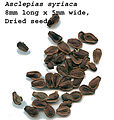- Asclepias syriaca
-
Asclepias syriaca 
Scientific classification Kingdom: Plantae (unranked): Angiosperms (unranked): Eudicots (unranked): Asterids Order: Gentianales Family: Apocynaceae Subfamily: Asclepiadoideae Genus: Asclepias Species: A. syriaca Binomial name Asclepias syriaca
L.Asclepias syriaca, commonly called Common Milkweed, Butterfly flower, Silkweed, Silky Swallow-wort, Virginia Silkweed, is a herbaceous plant species. It is in the genus Asclepias, making it a type of milkweed. This species is native to most of North America east of the Rocky Mountains, excluding the drier parts of the Prairies. It grows in sandy soils and appreciates lots of sunlight. It was one of the earliest North American species described in Cornut's 1635 Canadensium plantarum historia. The specific epithet was reused by Linnaeus due to Cornut's confusion with a species from Asia Minor.
Common milkweed is a herbaceous perennial plant growing to 1-2 m tall from a rhizome. The stem and all parts of the plants produce a white latex when broken. The leaves are opposite, simple broad ovate-lanceolate, 7-25 cm long and 3-12 cm broad, usually with an undulate margin and a red-colored main vein. They have a very short petiole and a velvety underside.
The flowers are grouped in several spherical umbels with numerous flowers in each umbel. The individual flowers are small, 1-2 cm diameter, perfumed, with five cornate hoods. The seeds are attached to long, white flossy hairs and encased in large follicles.
Contents
Uses
The plant's latex contains large quantities of glycosides, making the leaves and seed pods toxic for sheep and other large mammals, and potentially humans (though large quantities of the foul-tasting parts would need to be eaten). The young shoots, young leaves, flower buds and immature fruits are all edible raw.
Concerns about milkweed bitterness and toxicity can be traced back to Euell Gibbons, author of Stalking the Wild Asparagus (1962). It is theorized that Gibbons inadvertently prepared dogbane (Apocynum cannabinum), a poisonous look-alike instead. He devised a method to remove the bitterness and toxicity by plunging the young shoots into boiling water (not cold) and cooking for one minute, repeating the procedure at least three times to make the plant safe to eat. Gibbons' method was copied from book to book, dominating edible plants literature for forty years. Most modern foragers consider the bitterness/toxicity issue a myth. The plants have no bitterness when tasted raw, and can be cooked like asparagus, with no special processing.[1]
Failed attempts have been made to exploit rubber (from the latex) and fiber (from the seed's floss) production from the plant industrially. The fluffy seed hairs have been used as the traditional background for mounted butterflies. The compressed floss has a beautiful silk-like sheen. The plant has also been explored for commercial use of its bast (inner bark) fiber which is both strong and soft. U. S. Department of Agriculture studies in the 1890s and 1940s found that Milkweed has more potential for commercial processing than any other indigenous bast fiber plant, with estimated yields as high as hemp and quality as good as flax. Both the bast fiber and the floss were used historically by Native Americans for cordage and textiles. Milkweed oil from the seeds can be easily converted into cinnamic acid, which is a very potent sunscreen when used at a 1-5% concentration.
The flowers often constitute small traps for insects who cannot take off again. Several insects live off the plant, including the Monarch Butterfly (Danaus plexippus), the Milkweed Beetle (Tetraopes tetraophtalmus), Large Milkweed Bug (Oncopeltus fasciatus), Small Milkweed Bug (Lygaeus kalmii), the Milkweed Leaf Beetle (Labidomera clivicollis) and the weevil Rhyssomatus lineaticollis. The flower nectar has a high glucose content and was used by natives as a sweetener.
Deforestation due to European settlement may have expanded the range and density of milkweed. The plant can become invasive and often acts as a weed. It is naturalized in several areas outside of its native range, including Oregon and parts of Europe.
Gallery
References
- Common Milkweed page from the Natural Resources Conservation Service Plants Database
- Lamoureux, Gisèle and al (1978). Plantes sauvages des villes et des champs. Fleurbec/Éditeur officiel du Québec. ISBN 2-920174-00-2.
- Lamoureux, Gisèle and al (1981). Plantes sauvages comestibles. Fleurbec. ISBN 2-920174-03-7.
- Brother Marie-Victorin (1975). Flore Laurentienne. Les Presses de l'Université de Montréal. ISBN 0-8405-0018-1.
- Buchanan, Rita (1987). A Weaver's Garden. Interweave Press, Inc. ISBN 0-934026-26-9.
External links
Asceplias syriaca from Nature Manitoba
 Media related to Asclepias syriaca at Wikimedia CommonsCategories:
Media related to Asclepias syriaca at Wikimedia CommonsCategories:- Asclepias
- Butterfly food plants
- Flora of Canada
- Flora of the United States
- Flora of Alabama
- Flora of Maryland
- Flora of North Dakota
Wikimedia Foundation. 2010.








